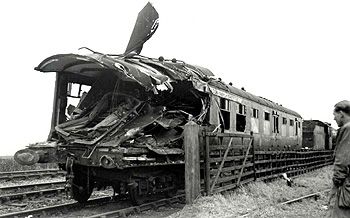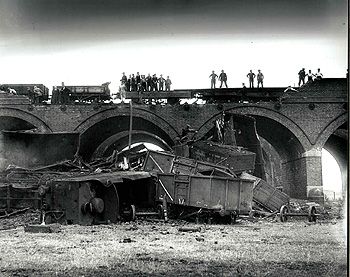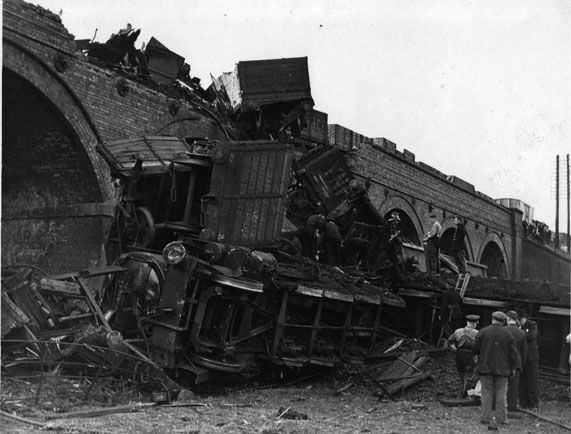The Wrecked Express

On 21st January 1938 there was a fatal railway accident at Oakley Junction. The late Fred Cockman wrote a piece on railway accidents in the county for theBedfordshire Magazine. It appeared in Volume XIV pages 319 to 326, published in Spring 1975. The following article is a transcription of what he wrote about the Oakley crash.
"On the Friday in question a train of empty stock from Bradford [Yorkshire] arrived at Oakley Junction drawn by engine Number 2893 with driver Cox in charge. The instructions from "Control" were that the stock was to be stabled on the Way and Works siding of the Northampton branch, but as some vehicles were already standing there the signalman J. Finnerty, found that only one half of the train could be accommodated, A further movement onto the main line would therefore be necessary to enable the coaches to be shunted onto an adjoining siding. This movement had to be delayed until the clearance of an up express at 14.46. In the meantime guard Turner of the empty train had gone to the signal box to discuss the matters with Finnerty. After spending some time in conversation Turner departed to find a scotch to place against the wheels of the stabled section of his train. So far all was well, and it only remained to await the 14.10 Saint Pancras to Bradford express which was due to pass the junction at 15.00. For some reason Finnerty then decided to bring out the empty stock onto the up main line, and from that moment things began to go wrong. The movement of the train, if unwise, would have been in order if Finnerty had blocked back to signalman Neale at Bromham signal box to explain the position, but he did not do so. He then displayed a green flag to Cox permitting him to emerge from the siding, but Cox moved forward only a few yards as guard Turner was missing, and then stopped. The movement of a few yards was decisive as the engine now stood on track circuit TC 886 which had the effect of locking the points in position and also the main line signals at danger. Neale now offered the Bradford express to Finnerty who accepted it thus breaking Regulation 4(f) which ruled "permission for a following train may be given only if the points are set for the train to pass". Finnerty now went to lower the main line signals but found the levers locked; he tried to reset the points but these levers were also locked. He vainly tried to get Cox to move back, but he could have broken a seal and released the grip of TC 886".
"Driver H. J. Hudson of the Bradford express was in charge of a powerful engine Number 5568 named Western Australia. He passed Bromham box with a clear road at 75 mph and then saw Oakley Junction distant signal at caution. He accordingly made a partial application on the brakes, and when he saw the home signal at danger he made a full application. But even with modern powerful brakes an express travelling at high speed requires some distance to stop, and the express was still travelling at 25 mph when the engines collided. The leading coaches of the Bradford train were thrown all over the place and three persons died and eight were injured".
"The Ministry of Transport enquiry was presided over by Colonel E. Woodhouse who arrived at the following conclusions:
- Finnerty had lost his head; he could have blocked back to Bromham box as the express was still four miles away.
- Driver Hudson should have made an earlier application of the brake.
- Guard Turner wasted too much time. He could have telephoned the box from the siding, but instead spent 23 minutes away from his train".
The Bedfordshire Times of 28th January 1938 recorded the following three fatalities:
- Albert W. Jones, aged 51 of Carlyle Road, West Bridgford [Nottinghamshire]. A native of Taunton [Somerset] he worked for Boots the chemists and left a widow and four children;
- Charles Reed Allensby, aged 56 of Hertford Avenue, East Sheen [Surrey], who died in hospital on the night of the crash. He was director of a firm of kitchen and heating engineers and was on his way to a branch dinner in Nottingham
- Harry Grainge, the restaurant car cook, from Vincent Road, Sheffield [Yorkshire] who died from chest injuries on the evening of 23rd January.
Those injured were listed as follows:
- A. Cox, the driver of the stationary train. He came from Saville Road, Leicester and had a broken leg;
- Frederick Dadd, a dining car attendant. He came from FinsburyPark, London and had scalded legs;
- George Nicholson from Stone Street, Sheffield. He had an injury to his eyebrow;
- Cyril Ferguson from Aspinall Road, Brockley, London. He had concussion;
- T. P. Sykes from Rotherham [Lancashire]. He had a broken arm;
- W. Barlow from Sheffield. He had a broken arm.
Ten more passengers were discharged from hospital with minor injuries.
Train Crash - 1949

Eleven years after the last fatal railway accident at Oakley another occurred on 4th October 1949. The Bedfordshire Times of 7th October reported it as follows.
A full inquiry has been ordered by British Railways into Tuesday's fatal accident at Oakley, when two Wellingborough men were killed in a collision between goods trains one of which was stationary on the Stafford Viaduct. The men were trapped in the cabin of one of the engines, which had plunged forty feet over the bridge into a meadow by the river, and it was some hours later, and only after intensive rescue attempts that their bodies were recovered. The men were John William Bailey (50), the driver, of 153 Mill Road and Charles Horace Richards (24), fireman, of 23 Eastfield Road.
It was the 1.35 pm Wellingborough to Brent (London) which ran into the rear of one from Toton (Nottinghamshire) to London.
The crash occurred at 2.15 pm and it was exactly four hours later when the body of the driver, Mr. Bailey, was dragged from the wrecked cabin after firemen under the supervision of Chief Officer E. T. Stanford had cut their way through the steel casing with oxy-acetylene flames and other apparatus. But at that stage it was not possible to reach the body of the fireman, which was not recovered until 3.20 am on Wednesday. The work of clearing the surrounding wreckage was continued non-stop throughout Tuesday night
Two hundred men were engaged on Wednesday in clearing the upturned trucks which blocked the lines and a stretch of 100 yards of prefabricated line was laid.
The damage caused by the collision will not be easily forgotten. The engine hurtling over the viaduct smashed through the 18 inch thick wall of the bridge causing a gap fully 30 yards long. In the field below hundreds of tons of coal from loaded tricks of both trains were heaped on top of the wrecked engine, wagons blocked the goods lines, others were dangling over the bridge, and more trucks were smashed on top of the coal. A twisted rail hung down over the viaduct, a telegraph pole by the bridge had been mangled to pulp and huge chunks of masonry littered the field. The smashed engine gave the appearance of having been battered by a giant hammer, and massive steel wheels of the wagons were clustered oddly around the debris.
Burning lumps of coal had been catapulted 50 yards from the bridge. Telegraph communications were interrupted.

FEAR OF FIRE
It was at first feared that the fire in the engine would spread to the heaped coal and the smashed woodwork from the trucks, and to avert this danger firemen sprayed water from the nearby River Ouse.
Eye-witness accounts at the scene did not reveal much about the actual crash, mainly because "everything seemed to happen so fast" as one person said to aBedfordshire Times reporter. In the cabin of the stationary train was Fireman N. Berwick, of Wellingborough, who said afterwards "There was a slight push and that was all".
"There was one big bang", said Mr. T. J. Turner, Post Office worker of Oakley, who heard the crash in the village a quarter-of-a-mile away. He came to the scene to help in rescue work.
"They did a magnificent job and set about it like Trojans", another person said, referring to the rescue workers (Bedford firemen, shirt-sleeved policemen and a railway squad) who began to clear away the mass of wreckage with pick and shovel. "They were sweating, grimy and tired, but they still carried on", was another tribute to these workers.
At one stage of the rescue operations it looked as if the wagons hanging precariously over the viaduct must surely come crashing down on top of the squad and work was halted for a moment when they were digging from one side of the heaped coal.
The guard of the stationary train, Mr. A. Cobb, had a very lucky escape, his van being smashed to pieces. He saw the other train approach ad ran up the line in the path of the train in an attempt to stop it, but he was too late, and he jumped clear only just in time to save himself from being mown down by the on-coming engine.
Mr. Alfred Hedge of Leys Road, Wellingborough, who was also in the guard's van of this train, had a remarkable escape from injury. He said after the accident: "I did not see a thing, all I felt was a bump".
DIRECTED BY RADIO
Among the first people on the scene were P. C.s Tompkins and J. Kirby, who were on duty in a patrol car. They were directed by radio from County Headquarters. Policemen on duty at the County Quarter Sessions were also sent to the viaduct. Ambulance-men and doctors were on constant duty by the wreckage, and villagers stood by watching the rescue attempts. It was a silent crowd.
Mr. R. Anderson, Deputy Chief Constable, Superintendent F. W. Kitchener and Inspector A. W. Norman were among the police officers present during the clearing operations.
An inquest on the two victims will be opened at Kempston Police Station this Friday afternoon.
Related to Robin Olney by Arthur Turner
Arthur Turner started working for the railways at the age of 15. In those days with the steam train stopping at every little station, it could take between two and three hours to get to London from Oakley. The four British railway companies: LMS, LNER, SR, and GWR had recently been nationalised into one system named British Rail.
Arthur worked in the Oakley station signal box. He did not actually do signalling, but recorded the number of every train which passed by the box, in a book. Immediately afterwards he would report this information to both main controllers, London (south) and Leicester (north). During its journey a passenger train would be passed from section to section. If a train approached a section which already held another train, it would see a red light. This was called the Absolute Block System. However goods trains were not under the same restraint, they worked under what was called the Permissive System.
In 1948 there was a serious accident on the viaduct at Oakley, and the permissive System was largely to blame. There were several goods trains waiting to pass through Bedford. They were queuing nose-to-tail from the Bromham signal box (half way to Bedford) all the way to Oakley viaduct. In those days most goods trains passing through Oakley were loaded with coal from the north.
Sharnbrook signal box allowed one such train to pass on towards Oakley. From Sharnbrook to Oakley there is a falling gradient. A fully loaded train takes an awful lot of stopping, especially when going down hill. We do not know if the driver or fireman saw the queue of trains, they probably had the distraction of just taking on water, but it seems they were unable to stop.
The guard on the rear of the parked goods train managed to jump clear. But the driver and fireman from the northern train were both killed when their engine crashed into the parked train and fell with some trucks onto the river bank.
After this disaster the goods train Permissive System was discontinued, and the Absolute Block System adopted for all trains. The repair work to the viaduct is still visible today.

